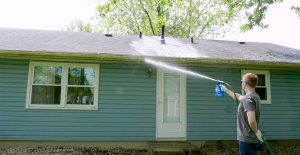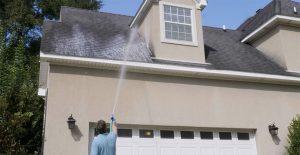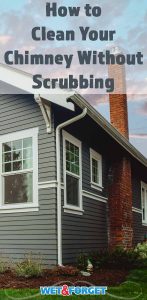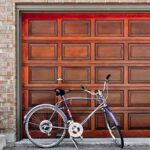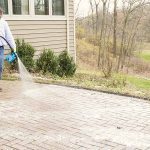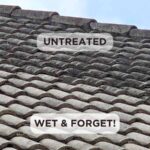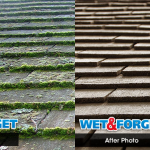Clean Gutters, Chimneys, and Eaves with Wet & Forget
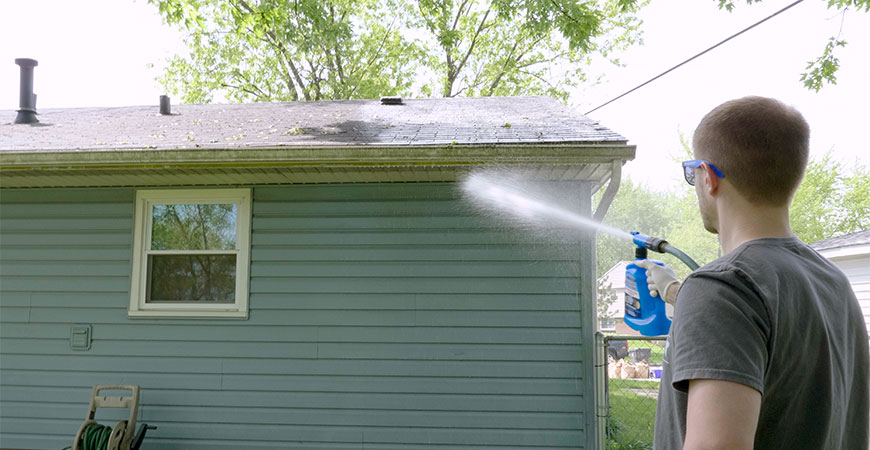
Cleaning your home’s high up areas such as gutters, chimneys, and eaves is a chore. These surfaces are prone to green and black staining, but because of how high up they are, it can be difficult and time consuming to acheive clean gutters, chimneys and more.
Here we’ll cover how to make sky-high cleaning a breeze, no ladder climbing required, with Wet & Forget.
How do I clean my chimney for the cold months ahead?
Brick chimneys and mortar are prone to water penetration. If the brick isn’t properly sealed, it absorbs water, which then creates a moist environment for moss, mold, and mildew to develop and grow.
Those blackish-brown stains that you see at the top of the chimney may look like creosote, but it may be mold and mildew. And if your chimney sits under tall trees and is in the shade most of the day, you may see moss, mold, and mildew, especially on the north side.
How to Remove Green & Black Stains on Your Chimney
- Connect Wet & Forget Hose End to your garden hose.
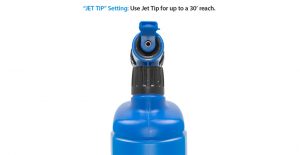
- The product comes with two spray tips: a fan tip and a jet tip.
The jet tip is best for height and distance. Connect the jet tip to the end of the sprayer and turn your water spigot on. (see photo above)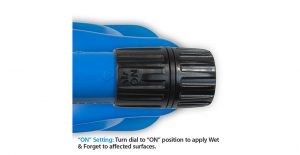
- Turn the black dial counterclockwise to the ‘ON’ setting. You will not be able to turn the dial further once reaching the ‘ON’ setting. (see photo above)
- Spray all sides of the chimney exterior.
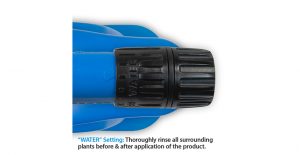
- When done, turn the dial to ‘WATER’ and rinse away any overspray on windows or landscape plantings. (see photo above)
- Turn off the water and allow the flow to diminish releasing water pressure.
- Remove the bottle from the garden hose and you’re done!
After the exterior is clean, it is a great time to apply a water repellant to the exterior of your chimney. Home repair expert Danny Lipford recommends waterproofing your chimney once every few years to keep water from seeping in.
Also, have a chimney professional check the mortar and to inspect the mortar crown. Broken mortar or cracks in the chimney crown will allow water to get inside the chimney.
What materials are used for chimney exteriors?
Masonry Siding: Most chimney exteriors are made of traditional brick or stone, with mortar in between. Over time, mortar may become brittle and crack.
Brick chimney exteriors are made of clay bricks, which are dried and cut into blocks. Stone exteriors are made of cut natural stone.
Wood Siding: Wood shingles or siding is often used as an exterior material for chimneys. Over time, a wood exterior can erode. This can cause water to get inside the chimney.
Wood knots that come loose can also allow water to move into the chimney structure. Wood-sided chimneys and flashing should be routinely inspected for interior leakage.
Aluminum Siding: Aluminum siding makes a durable chimney exterior as it doesn’t rot, doesn’t rust, and resists insect damage. Aluminum siding is also easy to replace if dented or damaged.
How do I clean gutters with Wet & Forget?
Cleaning gutters is a task that is best to complete in the fall season. Learn how to clean gutters with Wet & Forget with our step-by-step tutorial below.
- Connect Wet & Forget Hose End to your garden hose
- Attach the circular jet tip to the end of the sprayer
- Turn on your outdoor faucet. Turn the black dial counterclockwise to ‘ON’ and spray.
- Spray Wet & Forget onto the lower edge of the roof – just above the gutters. The product will flow into the gutter and down through the downspout.
- Also, apply the product to the outside of gutters and downspouts.
- When done, turn the dial to ‘WATER’ and rinse away any overspray on windows or landscape plantings
- Turn off the water and allow the flow to diminish, to release water pressure
- Remove the bottle from the garden hose and you’re done! Wet & Forget will work over time with the rain and wind to remove green and black stains, so you’ll have clean gutters without any scrubbing!
What are gutters made of?
Seamless Aluminum: A professional form seamless aluminum gutters, sometimes called continuous gutters, on-site. A spool of flat aluminum is fed into a machine that bends the material to shape.
The machine then cuts the aluminum to custom lengths. Professionally installed seamless aluminum is watertight to minimize leakage.
Aluminum: Aluminum is one of the most popular guttering materials for DIYers. It is easy to install and lightweight and available in a wide choice of colors to match your home’s exterior. Plus, it won’t rust!
Vinyl: Vinyl is another popular gutter material, which can be installed by the homeowner. Like aluminum, it is lightweight and easy to install.
The vinyl sections clip together. Vinyl is inexpensive, but the color choices are usually limited.
Copper: Copper guttering is beautiful and has high-end appeal but is usually costly. Copper guttering is often seen on historic homes. The initial bright copper color will weather to an attractive verdigris patina.
Copper required installation by a guttering professional as it requires welding at joints and seams. Like aluminum, copper does not rust.
Moss, mold, mildew and algae cannot grow on copper surfaces.
Galvanized Steel: Steel resists rust and makes for sturdy guttering. Galvanized steel is often expensive and heavy so installation is best performed by a professional.
Steel guttering is sold in a wide range of color options and can be painted to match your home’s exterior.
Zinc: Similar to copper, zinc guttering will take on an attractive patina, turning to a soft grey or blue-grey over time. Zinc is often used for historic restoration projects.
A gutter professional should install zinc guttering as welding is required. Although costly, zinc is weather-resistant and will last for decades.
How do I clean my eaves for the cold months ahead?
First, what are eaves? Eaves are a part of the roof structure. A home’s eaves extend out from the side of the home to provide shade to the exterior.
During construction, eaves are made as the rafters protrude past the outside walls. Eaves help lower cooling costs because they provide shade to exterior windows and your home’s exterior.
Wet & Forget Hose End cleans your eaves with ease – no ladder climbing required! Wet & Forget Hose End’s high-reaching sniper nozzle sprays Wet & Forget up to 30 feet high, allowing you to quickly and easily clean your home’s eaves.
Here’s how to clean your eaves with Wet & Forget Hose End:
- Connect Wet & Forget Hose End to your garden hose and attach the circular jet tip.
- Turn on your water faucet. Turn the dial counterclockwise to the ‘ON’ setting and spray.
- When done, turn the dial to ‘WATER’ and rinse away any overspray on windows or landscape plantings
- Turn off the water and allow the flow to diminish, to release water pressure
- Remove the bottle from the garden hose
- Since eaves aren’t exposed to direct rain, we advise rinsing the surface with a hose on a jet setting 1 week after your application and repeating the rinsing process periodically to imitate natural rainfall and help agitate the surface to remove the dead growth.
Wet & Forget Hose End’s gentle cleaning formula is non-acidic and doesn’t contain bleach or phosphates so it’s safe to use on virtually any outdoor surface. Plus surfaces stay moss, mold, and mildew-free for up to a year or longer!
To find Wet & Forget products at a store near you, click here. Or, send us a message here.
You can also give us a call Monday through Friday, 8:30am-5pm CT at 888-727-8524.

